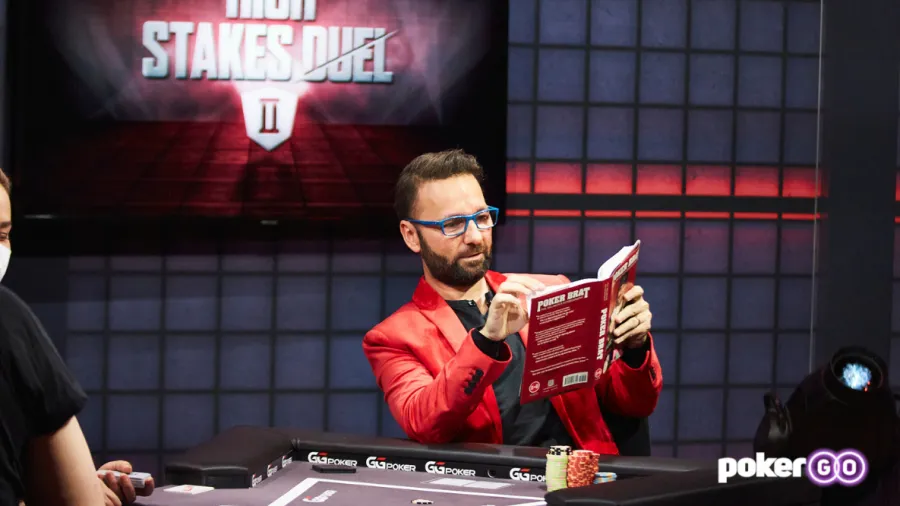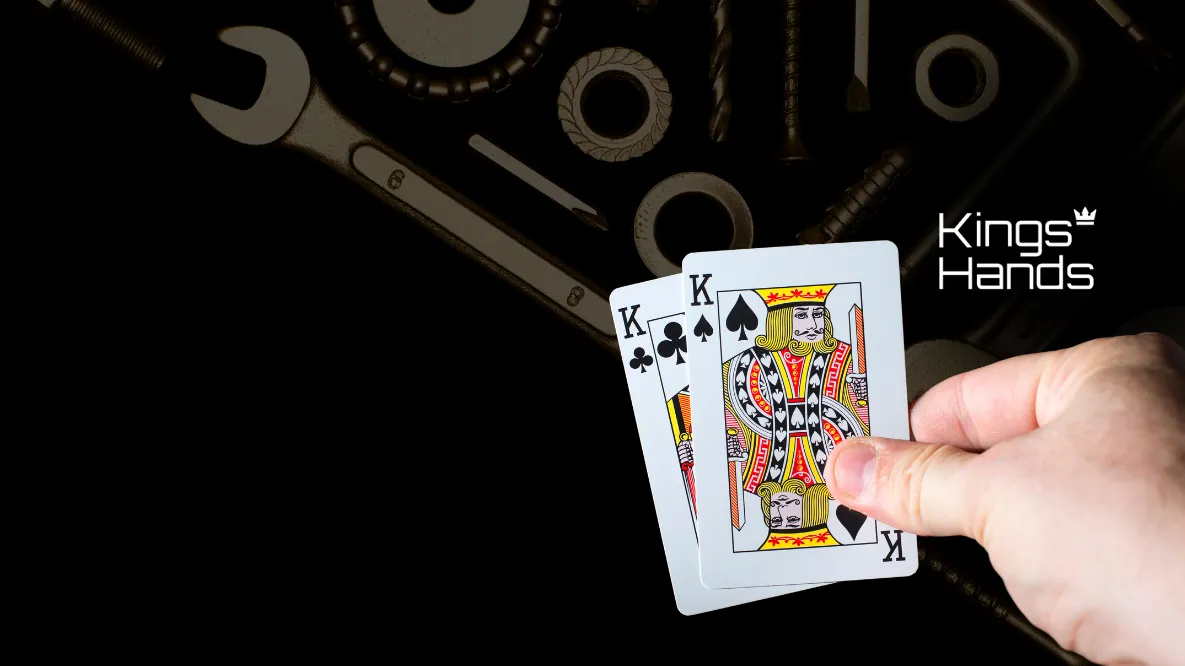Playing good postflop poker takes a good deal of work and study. In this series we’re going to open it up, and explore a lot of key areas to help you on your way in developing this skill set.
Of course many factors influence your ranges and your optimal lines postflop, including the game format.
In a game such as MTTs, for example, you will often be shorter-stacked, and also with relatively large pots which include antes. There will also be ICM effects which factor into how tight or loose you should play, and these effects may be harder to measure postflop but they still have an influence. Being shorter will mean more one or two street postflop lines, where the opponents have simply got all before the river.
In cash games, on the other hand, stacks are usually at least 50-100bbs effective, and there is usually no ante. Pots are smaller, ranges are somewhat tighter, but there’s far more complexity to postflop play due to the deep stacks. There are more complex lines possible with deeper stacks, and hence arriving at the optimal line vs. tough opponents is harder. Couple this with the lower variance in cash grind and you have a tougher format, stake-for-stake, and one with a lot more to think about postflop.
Still, the basic principles for postflop play apply equally to both of these formats, and we’ll explore these in today’s piece, an introductory voyage into the world of postflop poker. For the sake of consistency, we’ll consider cash game spots in this article.
Single Raised Pots
These are often referred to by their acronym as SRPs, and refer to any pot which has been raised preflop once only, so pots in which no 3bet / 4bet etc. has occurred. We’ll look today mainly at heads up pots to the flop, where there is an open raiser and a flat caller.
SRPs Raiser has Position
In these pots the raiser is in position (IP) and the flat caller is out of position (OOP). The most common example for this scenario is an opening position between UTG and BTN, and the BB in defence. Let’s look at a couple of spots where BB is defending against an IP open.
Using some incredible software called GTOTrainer we can quickly calculate what the game theory optimal solutions will be for different postflop situations. Bear in mind that in a real poker game our opponents will very often be playing nowhere near optimally, in which case we would opt to adapt these ranges. Nonetheless using such software will give us a very good idea of what kinds of hands to include in our betting range in a given spot.
Let’s look at a situation where the Cutoff (CO) has opened the pot in a $1 / $2 cash game to $5, the Button (BTN) and Small Blind (SB) have folded, and the Big Blind (BB) has called. Let’s pull up an average enough flop that doesn’t drastically favour either the BB or the CO, such as .
Game Flow
Game Flow is an important concept in poker, and it refers to the fact that once a player has taken an aggressive line and his opponent has only called, he has what is called initiative in the hand. He is the driving force behind the progress of the hand at this point, and it is usual for the caller (who is in this scenario OOP and acts first) to check to the aggressor. This is called acting in flow, and for the flat caller to bet into the last aggressor instead is known as lead betting or leading out. This is often not recommendable, but it’s something of a sign of a beginner if you see a player leading in a lot of spots, as they may simply not understand the significance of game flow.
That said, there are occasions where it may make sense to lead bet for strategic reasons, and GTOTrainer itself may suggest some lead bets in certain spots. These can still be hard to manage as strategies since they are unfamiliar to most players, but that may still make them interesting lines as your opponent may also be unfamiliar and uncomfortable facing these lines.
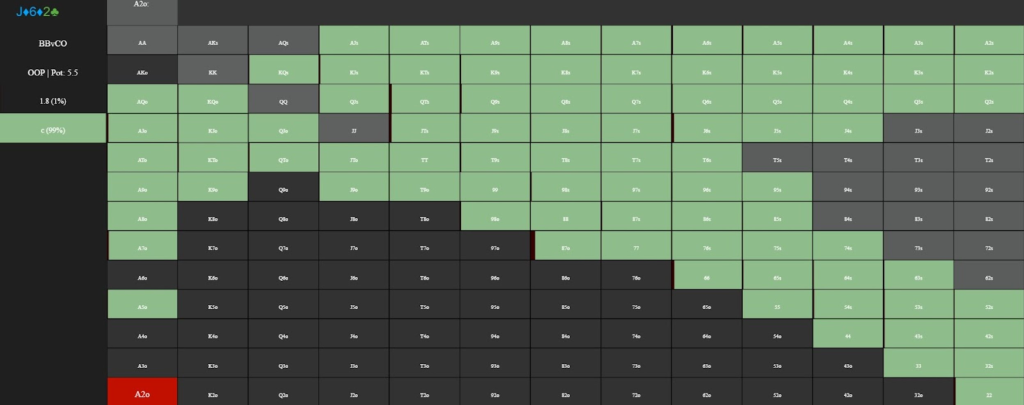
BB in defence vs CO open
As we can see however, in this case BB does not want to lead, at least not more than 1% of the time, even in the GTOTrainer simulation. We can surely simplify this 99% checking strategy into a 100% checking strategy without losing too much equity!
Continuation Betting
The preflop aggressor will usually have the option to continue betting in position after facing a largely procedural check from the OOP player. Let’s look at GTOTrainer’s recommended play on the flop for the CO here.
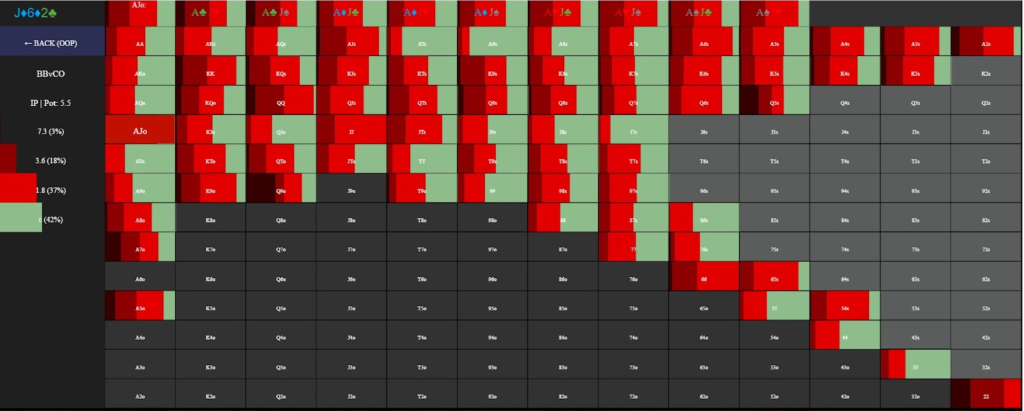
CO on the flop facing a check from BB
As you can see from the above image, GTOTrainer wants to take a mixed approach with most hands on the flop, meaning that we are mixing bets and checks with almost every hand combination. In reality one can take a more relaxed approach to this at most stakes and just mix up your gameplay without worrying about the exact frequencies.
What’s most important is to note here is that overall CO is continuation betting (c-betting) about 58% of the time. One common mistake made by a lot of regulars is to c-bet with too high a frequency without good reason, building a big pot without a coherent plan. There are some boards where you can c-bet a very high percentage.
Hands most favoured for a check here include mid-strength suited and offsuit aces except for those featuring the A♦ which always bet. Some weaker top pair, underpairs to the J as well as some 6x tends to check here quite a lot also.
GTOTrainer also recommends a mix of sizings here, but is mostly using 1/3rd pot as a sizing, which seems reasonable on a board with one paint card and some lowball cards. The more connected the board, generally you’ll want to use a larger sizing more often, although your betting frequency may go down.
Responding to a Continuation Bet
Let’s take a look at GTOTrainer’s recommendations for the BB facing a small 1/3rd pot c-bet from the CO.
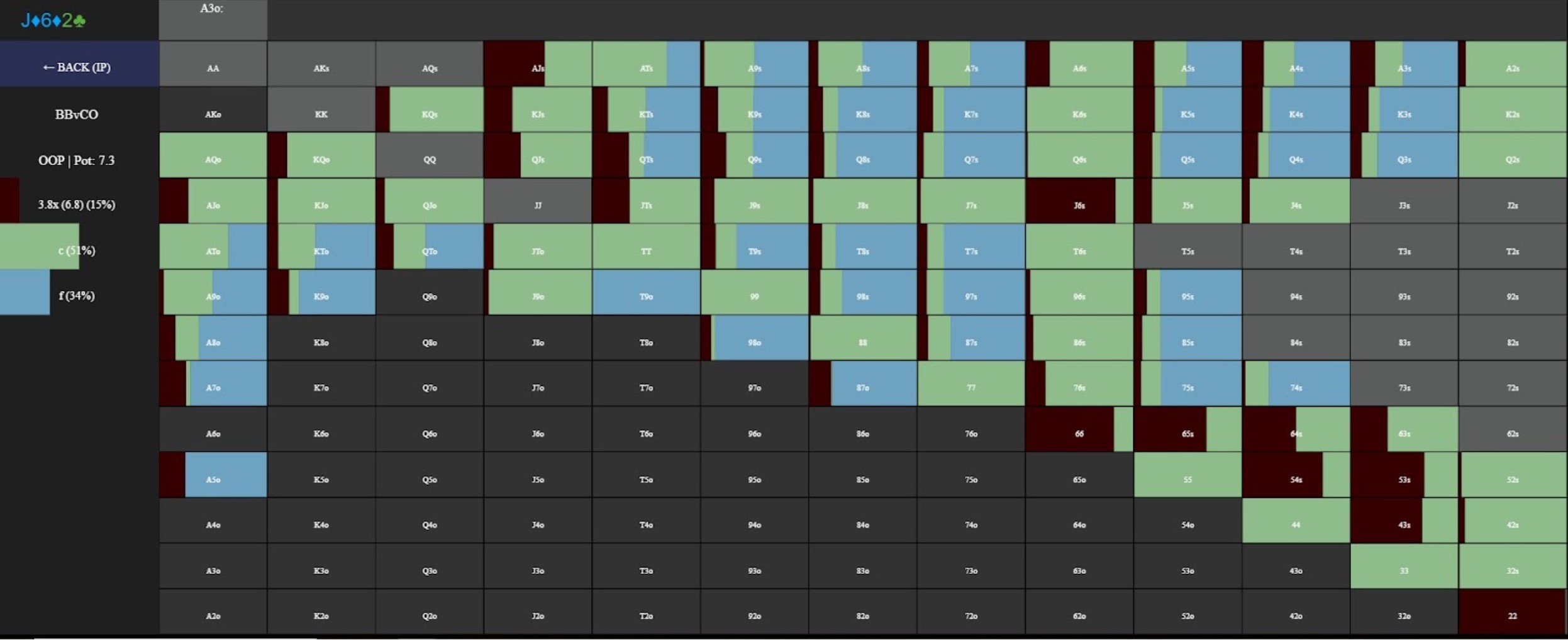
BB’s strategy against a small 1/3rd pot cbet from CO
As we can see above, BB is folding around 1/3rd of the time here. One mistake often made by students of the game is to overfold the BB. This is especially problematic if our opponent is cbetting even more than the 58% GTOTrainer recommends here, since we’ll be folding against an even weaker range. According to the above we are supposed to call here with hands as weak as 33 and even some Ax and Kx hands with backdoors to hit flushes or straights on the runout.
Another great takeaway from this data is the best check-raises BB has against CO’s cbetting range. GTOTrainer prefers to check-raise a lot with top pair, as well as top two, and its sets, naturally. However it also recommends raising a high frequency with hands such as 65s and 64s, 54s, 53s and 43s. These hands block important two card or set hands, as well as having combinations of backdoor or gutshot straight draws. This makes them quite appealing check/raise bluffs since they can continue on quite a few turn cards as a multi-street semi-bluff or hit a big made hand on turn or river.
How would we respond if we knew that CO was cbetting 100%? In this case he would have a far weaker range on the flop, and would be forced to surrender many more hands if we raised, so we’d be incentivized to raise much more often, probably making any mixed raising hands into pure 100% raises, and adding in more marginal hands as well to this raising range. We would also likely flat call a larger part of our range, and fold less overall. If we didn’t make these adjustments, CO would get away with making more money with his 100% cbetting range.
In reality this is a flop where some less experienced players will cbet more than this GTO 58%, but it’s unlikely many players will cbet 100% here these days, knowing that BB can play back with at least some strong hands and big draws. I’d expect to see lower than 70% cbet from most players in this spot across most stakes. Evaluating what the player pool tendencies are in a specific type of spot is also part of the skill set required for optimal decision-making.
It is worth mentioning here the difference between GTO and optimal play. GTO, game theory optimal, is how we would play if all participants were perfectly aware of one another’s ranges and strategic adjustments, and is an equilibrium which would be reached with this mutual knowledge and within a defined set of parameters, such as using a finite number of specific sizings. Change these parameters and you’d reach a different set of solutions, a different equilibrium. Optimal simply refers to what will be best in a specific circumstance against a specific player.
So there are many simple examples of when we would want to play in a way which is optimal against a specific villain but nowhere near GTO. For example if we know our opponent never folds we can play very thin and very large bets for value, but rarely are we ever going to bluff them. This unbalanced strategy will be golden against a calling station, but suicide against a good observant regular.
What about Turn and River?
Naturally as we proceed down the streets, our decision tree is going to get progressively more complex. We will often face scenarios where multiple lines can be considered optimal, or where a mix of lines can be considered best, depending on what we think our opponents are thinking.
Should we barrel turn after cbetting, or would a check/raise be better on a specific turn card? How often will villain call a turn bet on this card, but then fold to a blank river card (a card that changes very little with regard to the players’ ranges) if we fire off a final bluff in a triple-barrel bluff line? These are some of the toughest questions in postflop poker, since the tree of decisions becomes ever more complex as we proceed across multiple decision points for each player. Rest assured, PokerDeals has you covered for this too, as we’ll explore a wide range of specific spots in the postflop poker landscape in order to help you to map it all out.
For more awesome hand discussion and theory, as well as all the latest in poker, head over to the PokerDeals Discord today!
Image courtesy of PokerGO.com
